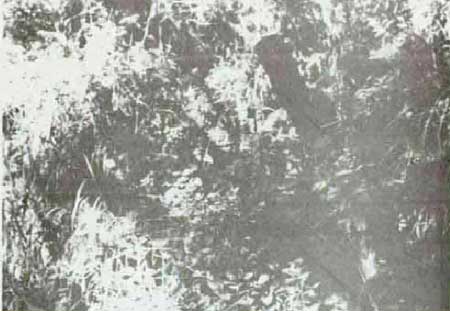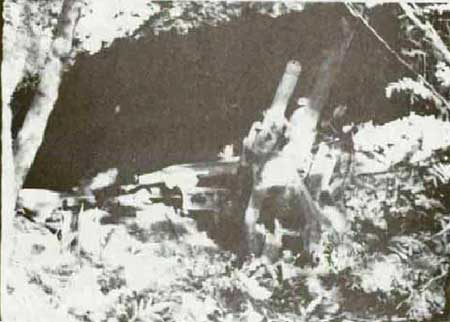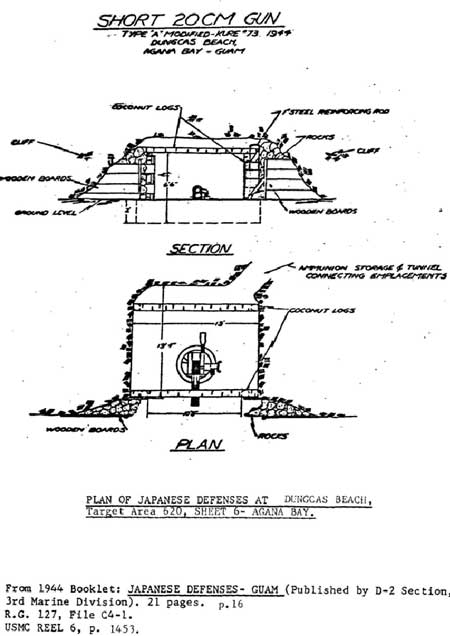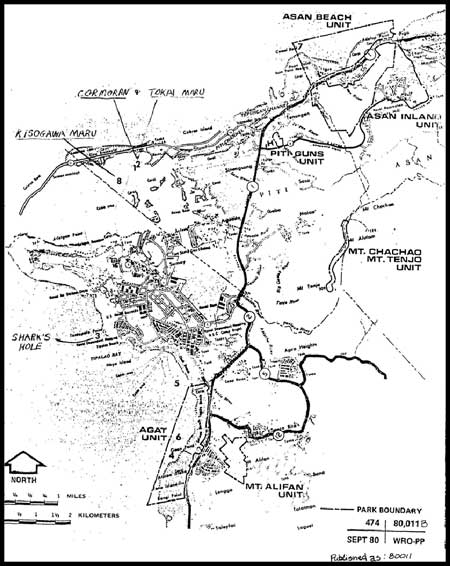|
War in the Pacific
War in the Pacific National Historic Park Historic Resource Study |

|
G. SITES NOT LISTED IN THE GENERAL MANAGEMENT PLAN FOR MARKING
I. Dungcas Beach 20cm Battery
The Japanese constructed this two-gun 20cm, short-barrel battery at Dungcas Beach on the east side of Agana Bay, on the same beach that the Japanese Special Naval Landing Force came ashore on December 10, 1941. Both guns remain in place, their field of fire being over Agana Bay, Adelup Point, and the Asan landing beaches. Behind Gun 1, a long tunnel was cut through the limestone ridge to a protected clearing in the rear. This tunnel, remains intact. At Gun 2, a long natural crevice led to the rear.
The battery is on private property and no on-site interpretation is provided. (It is listed in the brochure, "Guide to Guam's World War II Sites.") I his is the most impressive Japanese battery surviving on Guam. It is recommended that this easily-accessible site be considered as an addition to the list of Other Significant World War II Sites on Guam.

|
| Japanese 20cm gun battery, Dungcas Beach. |

|
| Japanese 20cm gun battery, Dungcas Beach. |

|
| Japanese 20cm, two-gun battery, Dungcas Beach, 1984. |

|
| Japanese 20cm, two-gun battery, Dungcas Beach, 1984. |

|
II. Underwater Resources
Several historic underwater resources have been identified at Guam, some of which are inside the park boundaries, others outside. Considering the growing interest in recreational diving at Guam as well as other islands in the Pacific, it is recommended that Guam's underwater resources outside the park boundaries be added to the list of Other Significant World War II Sites on Guam.
Within the Park Boundaries
No. 108. Landing Vehicle, Tracked (LVT). This submerged amphibious tractor lies off Gaan Point in the Agat Unit. It lies in 45 feet of clear water and is in good condition except that its 30 caliber machine gun has been removed. It is the property of the Government of Guam.
No. 109. Landing Vehicle, Tracked. This submerged amphibious tractor lies off the Asan Beach Unit. It, too, is the property of the Government of Guam.
Outside the Park Boundaries
Shark's Hole. The National Park Service's Submerged Cultural Resources Unit reports that this area, off Apuntua Point on the south side of Orote Peninsula, contains an amazing assortment of abandoned World War II equipment, including the remains of several landing vehicles. The water is extraordinarily clear and the debris, ranging at a depth of from 60 to beyond 200 feet, was dumped from the nearby cliffs.

|
| (click on image for an enlargement in a new window) |
German Auxiliary Cruiser Cormoran and Japanese Merchant Ship Tokai Maru. In an amazing coincidence World War I Cormoran and World War II Tokai Maru lie in 120 feet of water immediately next to each other in Apra Harbor. Both vessels are largely intact and lie keel to keel.
During World War I, the German auxillary cruiser Cormoran took refuge and was interned for the duration in Apra Harbor, the United States being a neutral country. When the United States went to war against Germany in April 1917, the captain of the Cormoran had the ship scuttled. (The crew was interned at Asan, at the same site occupied earlier by Filipino insurgents.) Tokai Maru is a Japanese armed transport sunk by U.S. forces in World War II. Both vessels are in relatively good shape, but have been stripped of brass.

|
| Tokai Maru |

|
| Cormoran |
Kisogawa Maru is a second Japanese merchant ship lying on the bottom of Apra Harbor. The freighter lies in 160 feet of water, not far from the above two vessels. The National Park Service dive team considers this vessel as possessing the most integrity of the three. A bow gun remains as do some of the portholes. The park staff has some doubts as to the correct identification of this vessel.

|
| Kisogawa Maru |

|
| <<< Previous | <<< Contents >>> | Next >>> |
wapa/hrs/secg.htm
Last Updated: 07-Mar-2005